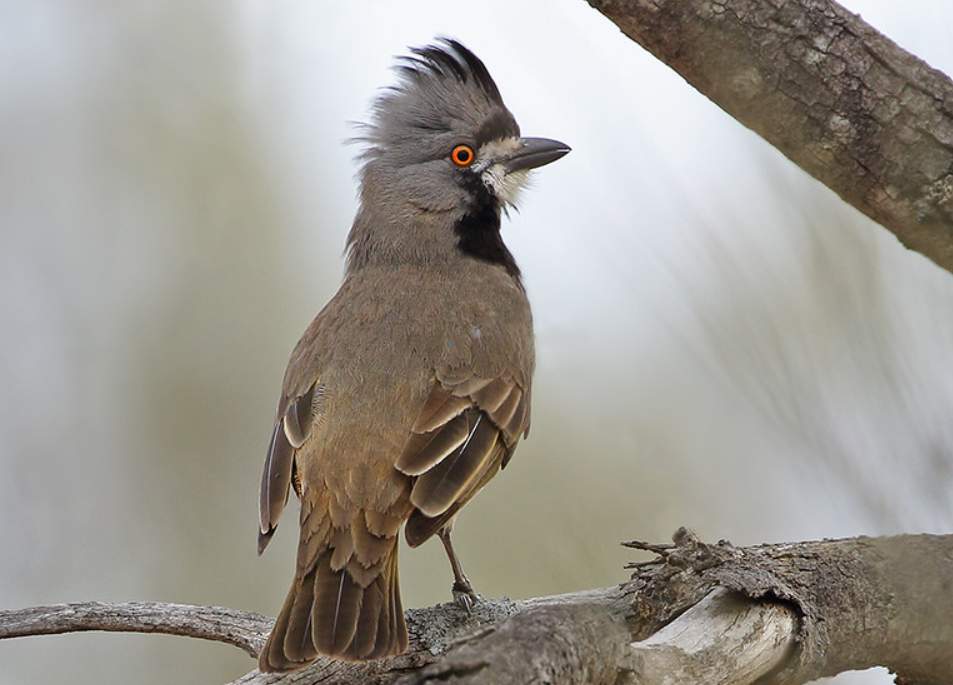Habitat: One aboriginal name for the Crested Bellbird (Oreoica gutturalis) was ‘panpanpalala’, an alliterative imitation of its song. This the male gives with a raised crest from a high, bare vantage point, often at the top of a tree, beaming it in all directions to signal his territory. As he swivels on his perch and varies the volume, the song can sound ventriloquial, although less frequently when not breeding.
In Australia, crested bellbirds are widespread throughout arid zones. These birds live in a range of lightly wooded habitats, from mallee woodland to belar casuarina and Mulga scrub. Although they are sedentary and rather solitary, the established pairs appear to hold to a rather large territory; occupant males will sing throughout the year. Moreover, crested bellbirds rise to trees and bushes to roost, sing, and nest, but even as they finish singing, males dive back in swooping undulations to the ground.

Vocalizations: Crested A bellbird call is a guttural chuck, or chuck-a-chuck-chuck, uttered when feeding. Occasionally, one can hear a pair of bird’s duets. However, the song is a distinctive series of five to six far-carrying mellow, liquid notes of ventriloquial quality, pan-pan-pallella, and the last three or four syllables slurred up and down together. Bellbirds also have a ventriloquial call. The call can sound as if it is coming from a few meters to the left, then to the right, then from behind, which can make it very difficult to identify the bird’s location.
Diet: The birds forage on the ground, hopping quickly but methodically along beneath shrubbery, plump bodies upright, picking for both insects and seeds. Caterpillars are prominent items, and the birds keep a larder of them around the nests.
Identification: The male bird’s face and throat are white, separated from the belly and crown by a black band on the breast that passes up through the eyes to join a black erectile crest along the center of the crown. The rest of the upper parts are flat brown, with cinnamon on the rump. Wings and tail were dusky, feathers edged grey-brown. Belly white, grading to ochreish on flanks and undertail. Eye yellow-orange. Bill black. Feet are dull gray.
The female forehead, lores, and sides of the head are gray; the rest of the upper parts are male. Small stripe of black on the crown, but the crest is vestigial. Underparts are cinnamon-brown, grading to white on the chin and belly. Eye red-brown. Bill is dark gray to black. The immature bird is similar to the female.

Nest and Breed: Their habit of ornamenting their nest with hairy caterpillars is unique. They squeeze each caterpillar in the middle, immobilizing it, and then attach it to the rim of the nest. Nesting and breeding occur from August to December or January in peripheral regions, triggered at any time by heavy rain in the arid central zone.
Nest a deep cup solidly composed of strips of bark, twigs, and leaves, adorned with live caterpillars; compactly lined with finer material, grass, bark, and leaves; placed in a hollow stump, in a thick vertical fork, or in the hanging bark of a tree, 1-3 meters above ground.
Eggs: Crested Bellbird lays 3 or 4 eggs that are white, spotted, and blotched sparingly with grey, black, and dark brown; long-oval, about 27 x 20 mm.
Distribution: A rid and subcoastal mulga and eucalypt scrubs and woodland of all inland Australia, north to the fringe of Kimberley’s and Arnhem Land, east to the western slopes of the Great Dividing Range, and south and west to most coasts; formerly locally east to coast in central eastern Queensland.
Size: The Crested Bellbird is about 200–220 mm long.
Family: The crested bellbird is a medium-sized passerine bird in the family Oreoicidae in the genus Oreoica.
Races: There are no races.
Other Name: It is also known as a bellbird.
Status: Despite its common status, this bird faces threats from habitat fragmentation in some regions, including Victoria.
Related Reading: White Bellbird – World’s Loudest Bird







